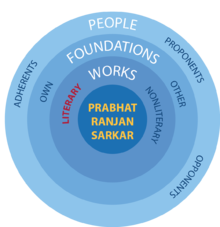Je tomare cay toma pane cay: Difference between revisions
(Song 516) |
m (Retranslated and removed PSUC flag) |
||
| Line 1: | Line 1: | ||
{{#seo: | {{#seo: | ||
|keywords=Prabhat Samgiita,Prabhata Samgiita,Prabhat Samgiit,Prabhat Sangeeta,Prabhat Sangeet | |keywords=Prabhat Samgiita,Prabhata Samgiita,Prabhat Samgiit,Prabhat Sangeeta,Prabhat Sangeet,longing | ||
|description=Song by Prabhat Ranjan Sarkar | |description=Song by Prabhat Ranjan Sarkar | ||
}} | }} | ||
| Line 61: | Line 60: | ||
</poem> | </poem> | ||
| <poem> | | <poem> | ||
The ones who long for You, who look to You, | |||
Those people why don't You see? | |||
At darkest night and in bright morning, | |||
Why do You stay mute? | |||
In | On sky and sea, in light, in gloom, | ||
A band of flowers, they have moved; | |||
But many hundred-petaled loti{{#tag:ref|In yoga, meditation on the Supreme Guru is typically performed at the ''guru cakra''. The ''guru cakra'' is visualized as a hundred-petaled lotus, and the Guru is seated therein. The ''guru cakra'' is located just below ''sahasrára cakra'' (the thousand-petaled plexus), located at or just above the anterior fontanelle.|group="nb"}} droop. | |||
For the good of all, to be impartial, | |||
Why not let Yourself be held? | |||
In many colors, approaching silently, | |||
Hopeful blossoms gaze toward Thee; | |||
Overlooked is so much yearning. | |||
In a soundless heaven keeping mum, | |||
What is this lute that You strum? | |||
</poem> | </poem> | ||
|} | |} | ||
Revision as of 05:31, 3 June 2016
| Je tomare cay toma pane cay | |
|---|---|
 | |
| Music and lyrics by Prabhat Ranjan Sarkar | |
| Song number | 0516 |
| Date | 1983 May 16 |
| Place | Madhumalainca, Kolkata |
| Theme | Longing |
| Lyrics | Bengali |
| Audio | <flashmp3>http://prabhatasamgiita.net/1-999-f/___516%20JE%20TOMA%27RE%20CA%27Y%20TOMA%27%20PA%27NE%20CA%27Y.mp3</flashmp3> |
| License |
|
| Location in Sarkarverse | |
Je tomare cay toma pane cay is the 516th song of Prabhat Ranjan Sarkar's Prabhat Samgiita.[1]
Lyrics
| Roman script[nb 1] | Bengali script | Translation |
|---|---|---|
Je tomáre cáy tomá páne cáy |
যে তোমারে চায় তোমা পানে চায় |
The ones who long for You, who look to You, |
Notes
- ^ For details on the notation, see Roman Bengali transliteration.
- ^ In yoga, meditation on the Supreme Guru is typically performed at the guru cakra. The guru cakra is visualized as a hundred-petaled lotus, and the Guru is seated therein. The guru cakra is located just below sahasrára cakra (the thousand-petaled plexus), located at or just above the anterior fontanelle.
References
- ^ Sarkar, Prabhat Ranjan (1994) Acarya Vijayananda Avadhuta, ed. Prabhat Samgiita Volume 1 (in Bengali) Kolkata: Ananda Marga Publications ISBN 81-7252-082-4
Recordings
- Listen to the song Je tomare cay toma pane cay sung by Acarya Priyashivananda Avadhuta on Sarkarverse
| Preceded by Tomar katha ogo prabhu |
Prabhat Samgiita 1983 With: Je tomare cay toma pane cay |
Succeeded by Ami tomay kabhu bhulibo na |
